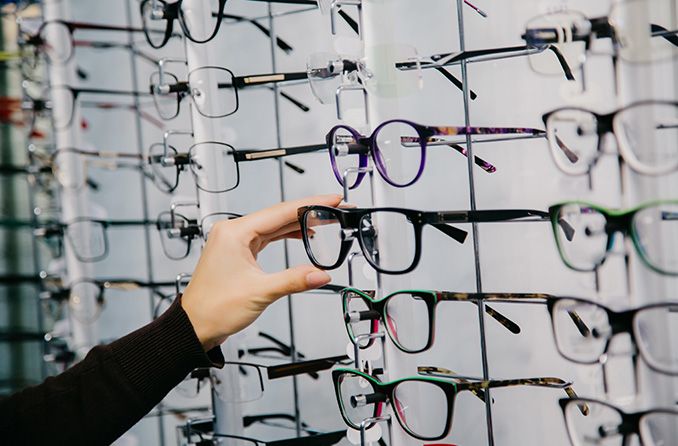
Buying Glasses
You’ve been to the eye doctor, had your exam and prescription. Now it is time to buy eyeglasses, our guide to Buying Glasses will lay out your options.

Quality features to look for in children's eyeglass frames and lenses.

When it comes to eyeglass wearers, no accessory is too extravagant. Here are 15 gift ideas, from lens cleaners to animal-shaped glasses holders.

From kids glasses to reading glasses, get the scoop on the best places to buy glasses online and in-store, with pros, cons and pricing.

Flexon eyeglasses frames are made with a special bendable metal that makes them extremely durable and flexible in addition to being super stylish.

After getting a prescription, where can you purchase your eyewear? Our buying guide will help you choose the right prescription lenses and frames to fit your face.

Discover how to buy glasses online, including what to look for in a reputable retailer for an optimal and convenient shopping experience.

Elegant and sophisticated, Cartier glasses are some of the most expensive available. Learn where to buy and how to spot a fake.

If you’re looking for a pair of Chanel glasses to complete your look, here's where you can buy Chanel designer frames online.

Thinking about buying low cost eyeglasses online? Benefits include lower prices and convenience; disadvantages include less personalized service.

Cheap glasses: How to find a bargain on eyeglasses

How to choose the best eyeglasses for your lifestyle.

When looking for the best glasses frames for your child, look for inexpensive and unbreakable glasses for kids (considering you'll likely have to replace them more often than your own). Check out these practical pointers for selecting the safest and most durable frames for your kids.

Learn about blue light glasses' possible health benefits and how blue light blocking glasses can protect your eyes from digital screen use.

Tom Ford glasses don’t just carry the prestige of a top luxury designer, they’re crafted with quality and durability in mind, too.

EyeBuyDirect has been named one of the best places to buy glasses online. Learn how Eye Buy Direct works and what kinds of glasses they sell.

Looking for a place to buy glasses online? Learn how Eyeconic works, how much it costs and the pros and cons of this online eyewear retailer.

Guide to eyeglass frames, lenses, lens materials, and coatings, with expert advice on how to buy eyeglasses and sunglasses.

Looking for reading glasses? Learn more about Foster Grant reading glasses, buying the right pair and how to shop for quality readers.

Looking for a place to buy glasses or sunglasses online? FramesDirect.com has good prices, a wide selection, top reviews and a long history in business.

Expert answers to FAQs about eyeglasses and eyeglass frames, including buying tips.

Trying to decide on the best place to buy glasses online? Here’s everything you need to know about GlassesUSA and their offerings.

Gucci glasses combine luxurious style, high-end design and quality materials; premium Gucci sunglasses additionally protect your eyes from the sun.

What features are available in low vision magnifiers? Evaluate types and costs to learn which low vision device will work best for you.

Buying Ray-Ban prescription glasses? Find out more about cost, frames and the best styles. Check out our full guide here.

This guide will show you how and where to buy Silhouette’s distinctive rimless glasses, as well as how to repair and replace their parts.

Learn the ins and outs of buying glasses online, from getting a prescription, calculating your pupillary distance, to picking a retailer and selecting the perfect frames and lenses..

How to find the best eyeglasses frames: This 9-point checklist covers frame styles, materials, shape and more to help you find the perfect frames for you.

Blue light from electronic devices can cause eye strain and headaches and disrupt sleep. Here are five of the best blue-light-blocking computer glasses.

Michael Kors eyewear is part of the “luxury lifestyle empire” by the beloved fashion designer and past Project Runway reality show judge.

Non-prescription glasses don’t require a prescription and are perfectly safe to wear. They are available in a variety of designs and materials.

Oliver Peoples sunglasses and glasses, born in 1980s Hollywood, feature high-quality lenses and a vintage aesthetic inspired by art, music and film.

Payne Glasses offers lenses and frames that are fashionable and cost-effective.

If you seek minimalism, comfort and flexibility in your eyewear, check out this guide to Starck glasses from an iconic French designer.

Unhappy with your new eyeglasses? Here's what you should know about refunds and other policies.

Learn about Ralph Lauren glasses, their iconic designs, and the brand's history. Discover the features of Ralph Lauren eyewear and where to buy authentic glasses and sunglasses.

Designer eyewear from Prada is popular among celebrities and features distinct, fashion-forward trends in glasses and sunglasses.

If you’re considering buying a pair of glasses from SmartBuyGlasses.com, here's what you can expect from this popular online eyewear retailer.

Looking for a great deal on a new pair of prescription glasses or sunglasses? It may be worth waiting to hit one of these hot seasonal sales.

If you prefer classic American style with a little flair, consider Tory Burch eyewear for your next pair of glasses or sunglasses.

Curious about the best places to get eyeglasses for kids? Options include: from your eye doctor’s office, optical chain stores like LensCrafters, Walmart Vision Center or Target Optical, and online retailers like EyeBuyDirect or Eyeconic.

Looking for an affordable pair of glasses? Our review gives you the details on Zenni Optical glasses and answers your questions about the online eyewear company.
All About Vision and AllAboutVision.com are registered trademarks of AAV Media, LLC. © 2000-2025 AAV Media, LLC. The content on this site is for informational purposes only. All About Vision does not provide medical advice, diagnosis or treatment. Contact an eye doctor if you need medical attention.